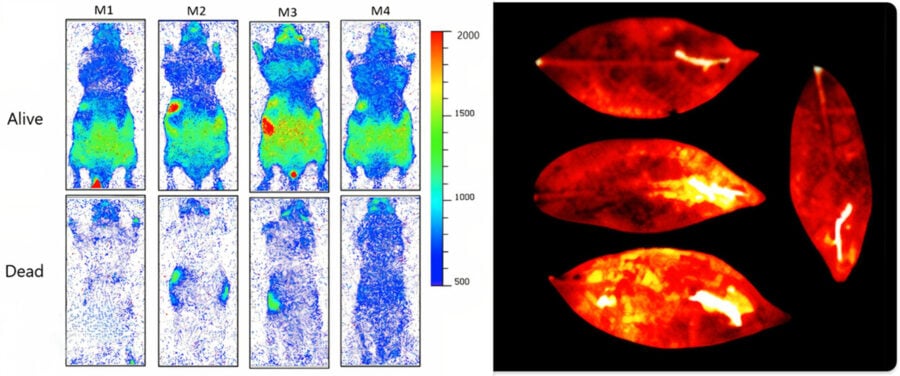Cutting-edge imaging technology has uncovered that all living organisms emit an extremely faint light invisible to the naked eye, with patterns that significantly differ between life and death. These ultraweak photon emissions (UPE) offer researchers a promising tool for non-invasive monitoring of biological processes and stress responses in both animals and plants.
What Are Ultraweak Photon Emissions?
Researchers at the University of Calgary and Canada’s National Research Council have developed sophisticated camera systems capable of detecting these almost imperceptible light signals, which typically range from just 10-1000 photons per square centimeter per second.
“The phenomenon of biological ultraweak photon emission has been observed in all living systems that have been examined,” the researchers note in their study published in ACS Photonics. Despite decades of investigation, scientists are still working to understand precisely what triggers this faint glow.
Unlike bioluminescence – the dramatic light seen in fireflies or deep-sea creatures – UPE occurs in all organisms but is thousands of times fainter. It’s also distinct from thermal radiation that all objects emit based on temperature.
Life vs. Death: Striking Differences in Emission Patterns
The research team utilized specialized electron-multiplying charge-coupled device (EMCCD) cameras with remarkable sensitivity – capable of detecting single photons with over 95% efficiency in the visible light range.
Perhaps most significant was the dramatic difference in emissions between living and recently deceased mice. After humane euthanasia, the mice showed markedly reduced photon emissions compared to when they were alive – despite maintaining the same body temperature of 37°C.
“The UPE imaging results show that the live mice consistently exhibit a significantly higher UPE intensity compared to their deceased counterparts,” the researchers reported. “This disparity illustrates a profound impact of a system’s vital state on UPE emissions.”
How might these findings translate to practical applications in biomedicine? The detection of UPE could potentially enable:
- Non-invasive monitoring of metabolic activity
- Early detection of stress-related abnormalities
- Real-time observation of physiological changes
- Enhanced understanding of cellular processes
Plant Stress Responses Revealed Through Light Emissions
The team also discovered that plants under various forms of stress display distinct emission patterns. When Arabidopsis thaliana plants were subjected to higher temperatures, their light emissions increased noticeably. Interestingly, when temperatures exceeded 36°C, emissions began to drop – suggesting that extreme heat disrupts the cellular processes responsible for the light.
Physical injury to plant leaves triggered increased emissions at the wound site. When researchers applied different chemical treatments to these injuries, they observed varying intensities of light emission. What surprised the researchers most?
Unexpected Findings with Chemical Treatments
Wounds treated with benzocaine – a common local anesthetic – showed the strongest emissions, even higher than those treated with hydrogen peroxide, which is known to enhance UPE. The mechanism behind this unexpected finding remains unclear, though researchers speculate it might be related to reactive oxygen species (ROS).
“The intensity of UPE emission from the injury site treated with benzocaine was far higher than even that of hydrogen peroxide, a well-known enhancer of UPE,” the researchers observed.
Future Applications and Implications
The practical applications of this innovative research could be far-reaching. For plants, UPE imaging might provide “a simple method for non-invasive monitoring of health abnormality and plant growth under different environmental conditions,” potentially benefiting agricultural practices.
In medical contexts, these techniques might someday offer “non-invasive label-free imaging of biochemical activities and metabolism in living systems,” the researchers suggest.
While still developing, this technology represents a promising approach to monitoring biological processes in real time without disrupting the systems being studied. As imaging technology advances, these ghostly emissions may illuminate aspects of life previously hidden from scientific observation.
What remains to be seen is how this technology might transform our understanding of the subtle energetic processes that differentiate living systems from non-living matter, and how these insights might lead to transformative applications in both medicine and agriculture.
Discover more from Wild Science
Subscribe to get the latest posts sent to your email.

